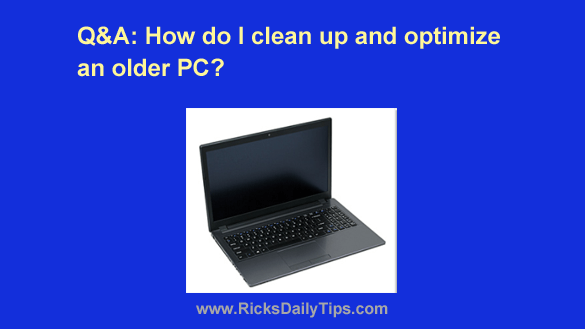 Question from Vicky: I got my old laptop out of the closet this morning to see if it still works. I’ve forgotten exactly how old it is but it’s running windows 10.
Question from Vicky: I got my old laptop out of the closet this morning to see if it still works. I’ve forgotten exactly how old it is but it’s running windows 10.
It finally booted up into Windows but it seemed to be running very sluggish.
At first, it wouldn’t connect to the wireless or open my Chrome browser. I checked to see how full the hard drive is. Not quite 50% is used.
I restarted it again and it connected to the network and loaded Chrome, but it’s still very sluggish.
Do you have any suggestions for cleaning up and optimizing an older computer?
Rick’s answer: Congrats on getting the old laptop up and running, Vicki! I recommend that you do the following things, in this order:
Note: The links in the steps listed below will open in a new tab. That will make it easy to return to this page to pick up where you left off.
1 – Thoroughly scan the machine for malware by downloading and running a scan with the free version of each of the tools mentioned in this post.
2 – Install the latest Windows Updates for your Windows installation (there will probably be a bunch of them) by following the instructions below.
3 – Download Geek Uninstaller and use it to completely remove any programs that you don’t plan to ever use.
Geek Uninstaller is a fantastic free utility that does a much better job at completely removing unwanted software than Windows’ own built-in uninstaller.
This post has instructions for downloading and using Geek Uninstaller.
Note: Reboot the PC after after you’ve finished deleting the unwanted programs.
4 – Download Autoruns and use it to ensure that your antivirus software is the only program that’s loading automatically with Windows.
There will probably be a lot of things loading that you won’t recognize, and I would leave those alone.
Just de-select any programs that you are familiar with but don’t want loading automatically with Windows.
Also, de-select anything with a “File not found” designation.
This post has instructions for downloading and using Autoruns.
Note: Reboot the PC after you finish de-selecting the unwanted startup items in Autoruns.
5 – Run Disk Cleanup on the C: drive to clean out any unused and orphaned files from your computer’s hard drive.
This Support page on the Microsoft website explains how to run Disk Cleanup in Windows 10/11.
That’s all there is to it, Vicky. Those seven things should speed up your laptop quite a bit.
However, if you still aren’t happy with your laptop’s performance you can always replace Windows with Linux for free.
If you only use this computer for Internet use you’ll be able to learn how to use Linux in just a few minutes. It comes with the very same Firefox browser that you use with Windows, and you can even install Google’s awesome Chrome browser if you want to.
If you’ll be doing other things besides just using the Internet you’ll need to replace your Windows applications with one of these free Linux replacements.
If you’re interested in taking the plunge and replacing Windows with Linux on this computer, this post has more information about that.
I hope this helps, Vicky. Good luck!
Bonus tip: If you ultimately decide that you want to keep using this laptop, replacing the hard drive with an SSD and/or adding more RAM will likely speed things up even more.